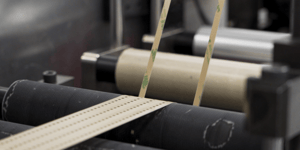Imagine you’ve been waiting for weeks to receive an order, but when you finally open the box, your parts are riddled with errors. Worse, even when you let your converter know about the problem, they fail to fix it.
Unfortunately, for many companies, receiving poor-quality parts is a common struggle. As a converter, other businesses often approach us to figure out why they’re having quality problems with their converter.
If your converter isn’t meeting your quality standards, look no further; we’re here to discuss problems you might see, reasons converters fail to meet standards, and ways you can ensure your project quality.
Common Converting Quality Problems
Before we address the cause of converting quality issues, let’s go over some of the more common quality issues you might encounter.
- Inconsistent parts
- Non-functional or poorly peeling adhesive
- Layering issues or liner misplacement
- Misaligned holes or registration marks
- Misprints
If you’ve suffered any of these problems in the past, you may have considered whether to switch converters. However, before you make such a paramount decision, it’s crucial to understand what causes these quality issues.
Reasons Why Converters Fail to Meet Quality Standards
There are many reasons why a converter might fail to meet quality standards.
1. THEY LACK THE RIGHT MACHINES
Imagine asking a magician to perform a magic trick, and their response was, “Sure! Can I borrow a wand?”
There’s a massive gap between the quality of machines within the converting space, largely due to the age at which it was manufactured. For instance, certain machines are highly adjustable, with individual motor control, while others are less sophisticated.
Depending on your design, your converter might not need highly advanced machines to achieve your desired results. However, custom products are so varied that each design can require a plethora of different processes.
Even though a converter might be able to technically perform a certain technique, defects can occur because your converter lacks the right equipment or personnel to properly build and perform quality checks on your product.
“Using non-adjustable converting machines is like trying to whittle with an axe.” — Zachary Tracey, Territory Manager at Strouse
Lastly, if you’re considering buying the machine yourself, recognize that you’ll also need skilled engineers and operators to build and maintain custom production processes.
2. FAIL TO ACCOUNT FOR TOLERANCES
Die cut tolerances define the acceptable range of measurements in your final product. These tolerances are often included in part drawings and are integral to achieving product accuracy.
Many projects undergo quality inspection processes to check specific features, like holes cut within a part, to ensure that everything is aligned correctly and fits within the acceptable tolerances.
Changing your design tolerances later on can cause significant issues depending on the converter’s machine and quality inspection capabilities. Design changes can be inevitable, but warning a converter about potential changes as soon as possible will help them set up and prepare the right processes.
3. USE THE WRONG MATERIAL
Although you may think of quality issues as appearing later in production, early decisions like material choice play an essential role in your product’s function and stability.
Choosing the wrong material can have serious financial consequences as you’re forced to waste time and resources on re-designs.
Because it’s more challenging to reach tight tolerance using certain flexible materials, this can increase the number of defects or the cost of your production process.
An experienced converter will take pre-emptive steps to mitigate material issues. Let’s say you designed a three-layered part using only extremely flexible materials. At Strouse, we might recommend using a structured material for one of the layers to make your process run more smoothly.
The thickness and type of material can also determine the machine you use. Sometimes, a significant material change can disturb the manufacturing and automation processes you’ve already invested in.
4. CHOOSE AN UNNECESSARILY COMPLEX DESIGN
Working with an inexperienced converter can result in an overly complicated product design for what the client aims to achieve.
Complex designs are more expensive than simple die cuts due to the type of material, tightness of tolerances, price of tooling, and more. You may realize your design is unnecessarily complex if you constantly have to adjust application components (like a jig) to match the product.
If you’re struggling, you may choose to revisit your design.
Optimizing your design for manufacturing will allow converters to build a far simpler production process. By simplifying your design, such as fewer layers with looser tolerances, you can save money and reduce the number of quality errors.
How To Ensure the Quality of My Project
As you may have noticed, many of the factors we mentioned are caused by converter oversights that occur relatively early in the process and set you up for failure.
One way to avoid major product quality issues is to define your expectations for quality control inspections, which will vary depending on the converter. If your converter can’t match your specifications, you might want to ask other converters whether they have the capabilities.
In addition, specifying the exact material, tolerances, format, and any other details will help your converter prepare your product exactly the way you want it.
- Disclose info about your product and application
- Talk about why you specced in certain materials
- Clarify how you’re looking to have these materials perform in your process
- Provide an accurate technical drawing
- Specify the most crucial measurements and tolerances
Now that you’ve learned more about quality standards in converting, what’s your next step?
If you want to find a converter who can help you optimize your process, consider asking for a consultation and figure out how much you can save by reducing quality defects with a converter who will help you improve your design efficiency.
Not ready for a quote but still want to learn more about converting? Check out our Learning Center for more.
%20(1)-min.png?width=290&name=Untitled%20(52)%20(1)-min.png)






